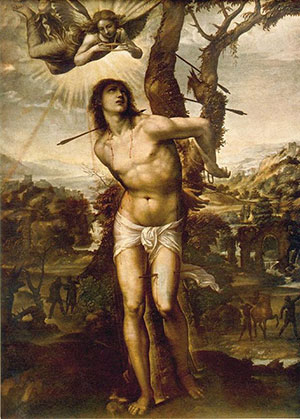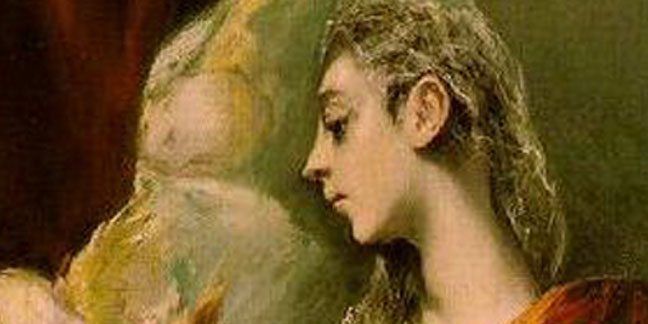Feast Day celebrated Jan. 20
 Nothing is known about St. Sebastian’s youth other than that he may have come from southern France and he was educated in Milan. He joined the Roman Army in 283 AD, ostensibly to be of service to other Christians who were being persecuted by the Romans. St. Sebastian distinguished himself, and for his excellent service, he was promoted to serve in the Praetorian Guard to protect Emperor Diocletian.
Nothing is known about St. Sebastian’s youth other than that he may have come from southern France and he was educated in Milan. He joined the Roman Army in 283 AD, ostensibly to be of service to other Christians who were being persecuted by the Romans. St. Sebastian distinguished himself, and for his excellent service, he was promoted to serve in the Praetorian Guard to protect Emperor Diocletian.
While serving as a Praetorian Guard, Marcus and Marcellian, twin brothers, were imprisoned for refusing to make public sacrifices to the Roman gods. The brothers were deacons of the Christian Church. During their imprisonment, their parents visited them to implore them to renounce Christianity. However, St. Sebastian convinced both parents to convert to Christianity. St. Sebastian also converted several other prominent individuals, including the local prefect.
This led to his discovery, and he was reported as a Christian to Emperor Diocletian in 286. The emperor, who was already infamous for ordering the deaths of hundreds of Christians, scolded Sebastian and ordered him to be killed by having him tied to a stake on a training field and used as target practice.
Archers riddled his body with arrows, and his body was described as, “full of arrows as an urchin.” Believed to be dead, the archers left his body for retrieval and burial. He was recovered by Irene of Rome, whose Christian husband was a servant to Diocletian and also martyred. Irene discovered that Sebastian was still living, and she hid him and nursed him back to health.
Once well, Sebastian went in search of Diocletian to surprise him. He managed to catch Diocletian by a stairwell and proceeded to criticize him loudly and publicly for his persecution of the Christians. Diocletian, surprised that Sebastian was still alive, was immediately taken aback, but recovered his composure. This time, he would not permit Sebastian to escape with his life. He ordered his former guard to be beaten to death with clubs, then thrown into the sewers.
His body was recovered by a Christian woman named Lucina, and she secretly buried him in the catacombs beneath Rome.
Nearly 80 years after his death, around 367, his remains were moved to a basilica in Rome, built by Pope Damasus I. His body, or at least some relics from his body, were reportedly removed and shared with a community of monks in France. His cranium was sent to a German monastery where it was placed in a special silver case in 934. The relic remains in its case today in a special reliquary in Ebersberg.
St. Sebastian was commonly invoked as a protector against the plague. According to historical records, he defended the city of Rome against the plague in 680.
His association with the plague could be because he survived being shot full of arrows and in pagan belief, pestilence was delivered by arrows shot by the gods above. Even Christian Romans would appreciate this symbolism. That symbolism is even captured in artwork as late as the Renaissance, where artists painted plague victims with black arrows in their body.
St. Sebastian is the patron saint of soldiers, athletes and those who desire a saintly death. His feast day is celebrated on Jan. 20.
 On Jan. 21, the Roman Catholic Church honors the virgin and martyr St. Agnes, who suffered death for her consecration to Christ.
On Jan. 21, the Roman Catholic Church honors the virgin and martyr St. Agnes, who suffered death for her consecration to Christ.
Eastern Catholics of the Byzantine tradition celebrate her feast day Jan. 14.
Although the details of Agnes' life are mostly unknown, the story of her martyrdom has been passed on with reverence since the fourth century. On the feast day of the teenaged martyr – whose name means "lamb" in Latin – the pope traditionally blesses two lambs, whose wool is later shorn on Holy Thursday and then used to weave the white pallium worn by every archbishop.
Born into a wealthy family during the last decade of the third century, Agnes lived in Rome during the final major persecution of the early Church under the Emperor Diocletian. Though he was lenient toward Christians for much of his rule, Diocletian changed course in 302, resolving to wipe out the Church throughout the Roman Empire.
Agnes came of age as the Church was beginning to suffer under a set of new laws decreed by Diocletian, and his co-ruler Galerius, in 303. The emperor and his subordinate called for churches to be destroyed and their books burned. Subsequent orders led to the imprisonment and torture of clergy and laypersons, for the sake of compelling them to worship the emperor instead of Christ.
Meanwhile, Agnes had become a young woman of great beauty and charm, drawing the attention of suitors from the top ranks of the Roman aristocracy. But in keeping with the words of Christ and St. Paul, she had already decided on a life of celibacy for the sake of God's kingdom. To all interested men, she explained that she had already promised herself to a heavenly and unseen spouse.
These suitors both understood Agnes' meaning and resented her resolution. Some of the men, possibly looking to change her mind, reported her to the Roman government as a Christian. Agnes was brought before a judge who tried first to persuade her, then to threaten her, into renouncing her choice not to marry.
When the judge showed her the various punishments he could inflict – fire, iron hooks, and the rack – Agnes smiled and indicated she would suffer them willingly. Instead, she was brought before a pagan altar and asked to make an act of worship in accordance with the Roman state religion.
When Agnes refused, the judge ordered that she should be sent to a house of prostitution, where the virginity she had offered to God would be violated. Agnes predicted that God would not allow this to occur, and her statement proved true. The first man to approach her in the brothel was struck blind by a sudden flash of light, and others opted not to repeat his mistake.
But the Roman governor's son Procop, who had at first sought to make Agnes his own, lobbied the judge for her execution and she was sentenced to die by beheading. The executioner gave her one last chance to spare her life, by renouncing her consecration to Christ – but Agnes refused, made a short prayer, and courageously submitted to death.
St. Agnes, who died in 304 at about age 13, was venerated as a holy martyr from the fourth century onward. She is one of seven women saints, excluding the Blessed Virgin Mary, commemorated by name in the Eucharistic Prayer at Mass. The saint's statue is also among those on the colonnade in St. Peter's Square.
She is the patron saint of chastity, gardeners, girls, engaged couples, rape victims and virgins.
— Benjamin Mann, Catholic News Agency

